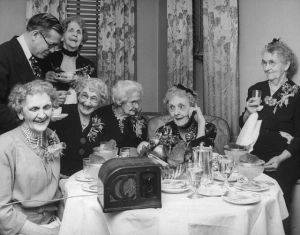
This handsome fellow, the Prime Minister of Portugal in the early 1900’s, was part of the visual landscape of my teens and early twenties. Observing from above an antique sideboard, soft eyes, bookish pince-nez, framed by brass candle sticks, he eavesdropped on his granddaughter, Maria, and me for decades.
You might imagine us in a mansion, relaxing in ball gowns on the velvet divan, champagne bubbles in our noses, under the watchful gaze of Grandfather. The “mansion” was a 1200 sq. foot condo in Phoenix, and Maria was a widow in her fifties when I met her, working as an Executive Secretary.
We met at my mother’s house circa 1983. I was 14; Maria was 50. We were chatting happily in the corner–Maria is a talented conversationist— when my mother interrupted:
“Maria did not come here to talk to you,” she said. I can still see my mother pulling diminutive, 4’11” Maria away.
My mother’s declaration that Maria did not want to talk to me stayed with me for 30 years, causing me wonder during conversations, Is this person here to talk to me? or after conversations, Did I talk too much? These are not bad questions to ask; they keep one humble. And quiet.
I nurtured this doubt until two things happened: time — Maria and I, 30 years later, are still having conversations, independent of our previous connection — and my daughter turned 14.
My now fourteen-year-old daughter prefers Schrödinger’s cat to Hello Kitty and  she reads Stephen Hawking. I was going to read up on Schrödinger’s cat to explain it to you, and maybe sound smart, but I don’t get it. You are invited to try here. Please feel free to explain it to me in the comments below. When my daughter and I disagree, she points out when I’m using a Red Herring to divert her and when I try to talk about spirituality and God’s presence she says I am a victim of Confirmation Bias.
she reads Stephen Hawking. I was going to read up on Schrödinger’s cat to explain it to you, and maybe sound smart, but I don’t get it. You are invited to try here. Please feel free to explain it to me in the comments below. When my daughter and I disagree, she points out when I’m using a Red Herring to divert her and when I try to talk about spirituality and God’s presence she says I am a victim of Confirmation Bias.
I enjoy talking to my 14-year-old daughter. In 1983, I may have been talking about clothes, music and hair dye, not Schrödinger, Hawking and Red Herrings, but it is not outside the realm of possibility that Maria and I were engaged in pleasant enough conversation, just like we have been ever since. My mother did not think that possible. She thought I was torturing her guest.
At 14, the only adult conversations I was having were on the weekends with my father. Then Maria appeared, a polyglot who had lived all over the world, with whom I likely had very little in common at the time, talking to me. The Book of Corinthians teaches,
Love is patient, love is kind. It does not envy, it does not boast, it is not proud. It does not dishonor others, it is not self-seeking, it is not easily angered, it keeps no record of wrongs . . . It always protects, always trusts, always hopes, always perseveres.
Could we not say that these are the requisite ingredients for a pleasant repartee? Love, kindness, humility, a dearth of anger and complaints, trust in the other person and perseverance through the boring bits? Any great relationship starts with as much. Mortimer Adler states,
“Love without conversation is impossible.”
Even cloistered nuns, living lives of prayer, work, sacrifice and silence, break silence one hour a day to talk. If practiced mindfully, dialogue is a form of love.
When visiting the other night, my friend, Clare, mentioned she thought the statue in my bathroom was ugly, sandwiching it with “Everything else in your home is so beautiful.” That stung, but I chose not to keep a record of wrongs. Well, I’m writing about it, so that’s not true. Later that night, she mentioned my blog post on homosexuality, and how I had broken Church teaching, not regarding homosexuality, but regarding another matter.
“No, I didn’t.”
“Yes, you did. You said. . .”
“No, I didn’t.”
We persevered, Clare feeling justified, my feeling defensive, passing through all sorts of awkwardness. Finally, we arrived; it was a matter of an ellipsis on my part combined with a negative assumption on her part. The art of conversation is a hot mess.
In a lovely article in The Atlantic, Megan Garber writes,
Conversations, as they tend to play out in person, are messy—full of pauses and interruptions and topic changes and assorted awkwardness. But the messiness is what allows for true exchange. It gives participants the time—and, just as important, the permission—to think and react and glean insights.

Enduring the awkwardness is conversation; committing to the awkwardness is love.
When she retired, Maria wrapped up Grandfather in brown paper and tied him up with string. When stopped with the package by the customs agent in Portugal, Maria stated, “He’s yours. I’m just bringing him back.” Back to eavesdropping in his native tongue.

